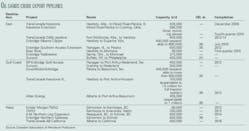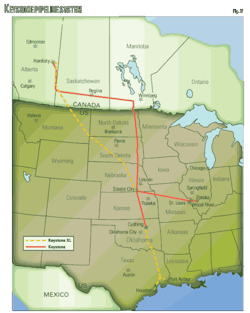More than 1 million b/d of extra crude pipeline capacity will run from western Canada by the end of 2010. Matching supply, however, will not be online until 2016, according to the most recent estimates from the Canadian Association of Petroleum Producers.1 This gap, and the general economic slowdown which helped create it, have caused development of export pipeline projects out of Canada beyond the three already approved and in construction (TransCanada Keystone, Enbridge Alberta Clipper, and TransCanada Keystone Extension) to slow, with some projects tabled indefinitely.
The accompanying table provides an overview of the new-construction oil sands crude pipeline projects. This article will look at oil sands crude supply and demand and then examine in greater detail some of the larger sands pipeline projects currently moving forward.
Supply, demand
The primary source of crude for any of these pipeline projects will be the Alberta oil sands. The Alberta Energy Resources and Conservation Board reports 170.4 billion bbl of remaining established bitumen reserves in the oil sands.2
The Hardisty, Alta., crude hub has a total inbound pipeline capacity of about 2.8 million b/d, supplemented by rail and truck deliveries. It also has 18 million bbl of storage.3 TransCanada’s Section 52 application for its Keystone XL pipeline project states the Hardisty hub will provide the pipeline with access to a wide variety of both light and heavy crudes for shipment to the US Gulf Coast. Fig. 1 shows inbound and outbound flows from Hardisty as well as the capacities of major storage operators at the hub.
As part of its filings with the NEB, TransCanada had Purvin & Gertz Inc. (PGI) conduct an assessment of the potential supply-demand balance between Western Canadian crude oil and US gulf refineries. PGI forecast supply growth between 2007 and 2017 of 1.55-2.42 million b/d.4 The assessment also noted the US Gulf Coast refining market currently only received 65,000 b/d of Canadian crude via the Pegasus pipeline but had coking capacity sufficient to run large amounts of heavy crude.
PGI also noted US Gulf Coast capacity to use heavy crude had been expanding at the same time supplies of heavy crude have been falling. For example, Motiva is conducting a large expansion at its Port Arthur refinery, adding 325,000 b/d of new crude capacity and 95,000 b/d of new coking capacity by 2011.5
PGI estimated the US gulf market could absorb a minimum of 500,000 b/d of Canadian crude. PGI also estimated that without Keystone XL, heavy crude oil pipeline capacity out of Western Canada would reach capacity by 2015.6
Keystone
TransCanada Corp.’s 2,148-mile Keystone pipeline project will transport crude oil from Canada to the US Midwest. In addition to 1,379 miles of newbuild US line, Keystone includes additions to existing Canadian pipelines and mainline flow reversals. It is expected to start in December 2009 with the capacity to deliver 435,000 b/d from Hardisty to the US at Wood River and Patoka, Ill.
TransCanada plans to extend the line to Cushing, Okla., starting fourth-quarter 2010, expanding to 590,000 b/d. The project has secured firm long-term contracts totaling 495,000 b/d for an average of 18 years (OGJ, Feb. 9, 2009, p. 56).
New pipeline will have a 30-in. OD to Illinois and 36-in. OD from the Nebraska-Kansas border to Cushing, buried to a minimum depth of cover of 4 ft. The estimated operating pressure of the new pipeline sections will be 1,440 psi. Existing pipeline converted to crude oil transportation will operate at its current approved allowable operating pressure of 880 psig.
New pipeline construction of 101 km in Manitoba was ~98% complete as of April 15, 2009. In Alberta, 202 of 280 km had been welded, with overall work ~50% complete. Conversion of existing pipelines was ~60% complete. TransCanada expects mechanical completion of Canadian pump stations by fourth-quarter 2009. Construction of three storage tanks, a pump station, and meter manifold piping at the Hardisty terminal was ~40% complete as of TransCanada’s Apr. 15 update.7
The same update described Keystone’s two spreads in North and South Dakota as 90% completed at end-2008.
As of June 7, 2009, the weekly pipeline construction progress report filed by TransCanada with the US Federal Energy Regulatory Commission (FERC) covered work under way in South Dakota between mileposts 217.8 and 438.0. Activities included:
- Erosion, sedimentation control; cleanup.
- Surveying.
- Top soiling, grading.
- Stringing, bending pipe sections.
- Welding, coating field joints.
- Road bore.
- Potholing.
- Mobbing equipment to the right-of-way (ROW).
- Clearing.
- Coating tests.
Work also progressed on four pump stations along the same stretch of pipeline.
TransCanada plans work on a total of six spreads in South Dakota, Nebraska, Kansas, Missouri, and Illinois during 2009. Land easements for its 2009 construction plans are 99% complete. The company has begun work on a total of 23 US pump stations, scheduled for mechanical completion in fourth-quarter 2009.7
XL
TransCanada announced plans in July 2008 for the Keystone Gulf Coast Expansion Project (Keystone XL), providing 700,000 b/d additional capacity from western Canada to the US Gulf Coast by 2012. Keystone XL has secured firm contracts for 380,000 b/d for an average of 17 years from shippers.
Keystone XL includes 1,980 miles of 36-in. OD line starting in Hardisty and extending to a delivery point near existing terminals in Port Arthur, Tex. (Fig. 2). XL will also include 41 pump stations—33 in the US and 8 in Canada—situated at roughly 50-mile intervals. Each pump station will use two to three 6,500 hp electric pumps, providing a total of up to 19,500 hp/station. Each station could be expanded to 32,500 hp to boost line capacity.
Subject to shipper support, Keystone XL will include an additional 50-mile lateral to Houston. TransCanada anticipates beginning construction in 2010, pending regulatory approvals, and intends to start the line in 2012. Construction will take place in both frozen and unfrozen conditions, at an average rate of 2-4 km/day, according to TransCanada’s Section 52 application for the project.
Canada’s National Energy Board (NEB) has scheduled an oral hearing on an application by TransCanada to construct and operate the 327-mile Canadian portion of Keystone XL, extending from Hardisty to the US border at Monchy, Sask., for Sept, 15, 2009.
Canadian construction will include two major water crossings: Red Deer River and South Saskatchewan River, both in Alberta. A feasibility report completed by TransCanada and included in its Section 52 application showed horizontal directional drilling could be used for both crossings. In the event HDD could not be completed, Trans- Canada would use a two-stage coffer damn isolated crossing technique for Red Deer and either this technique or open cut construction for South Saskatchewan. HDD work will take place in late 2010 and early 2011.8
TransCanada’s overall Canadian construction schedule calls for:
- Pipeline construction from fourth-quarter 2010 to third-quarter 2012.
- Construction of the Hardisty B terminal and pump station from third-quarter 2010 to second-quarter 2012.
- Intermediate pump station construction from third-quarter 2011 to third-quarter 2012.
- Commissioning and line fill from second-quarter 2012 to fourth-quarter 2012.9
The US portion starts at Morgan, Mont., extending 836 miles of newbuild pipeline southeast through South Dakota and Nebraska to Steele City. At Steele City, Keystone XL will connect to the 36-in. planned extension of Keystone and run 296 miles into Cushing. The final 478-mile newbuild stretch from Cushing to Port Arthur would complete the line.
Enbridge
Enbridge expects its 1,000-mile, 36-in. OD Alberta Clipper pipeline to enter service between Hardisty and Superior, Wis., in mid-2010, initially moving 450,000 b/d but with ultimate capacity of as much as 800,000 b/d.
The company has also renewed plans to build the 525,000-b/d Northern Gateway Pipeline from near Edmonton to a tanker terminal near Kitimat, BC (Fig. 3), for shipment to China, other parts of Asia, and California. Enbridge put the 1,170-km, 36-in. OD project on hold in December 2006 to focus on completing its Southern Access-Southern Lights project. A line running parallel to the crude line would ship 193,000 b/d of condensate from the coast to Alberta.
Enbridge expects to build Northern Gateway in 2012-14, pending regulatory approval of filings made this year. Commissioning and start-up would occur 2014-15. Enbridge would also operate the Kitimat terminal. The terminal would have 2 mooring berths, 14 storage tanks for petroleum and condensate, and be called on by roughly 225 ships/year.
References
- Canadian Association of Petroleum Producers, “Crude Oil Forecast, Markets & Pipeline Expansions,” p. ii, June 2009.
- Energy Resources and Conservation Board, “ERCB ST-98 2009: Alberta’s Energy Reserves 2008 and Supply/Demand Outlook,” p. 3, June 2009.
- TransCanada Keystone Pipeline GP Ltd., “Keystone XL Pipeline Section 52 Application,” Section 3: Supply and Markets, p. 3, Feb. 27, 2009.
- TransCanada Keystone Pipeline GP Ltd., “Keystone XL Pipeline Section 52 Application,” Section 3: Supply and Markets, p. 6, Feb. 27, 2009.
- Wise, T.H., Purvin & Gertz Inc., “Western Canadian Crude Supply and Markets,” p. 15, Feb. 12, 2009.
- TransCanada Keystone Pipeline GP Ltd., “Keystone XL Pipeline Section 52 Application,” Section 3: Supply and Markets, p. 7, Feb. 27, 2009.
- TransCanada, “Keystone Update and Other Pipeline Opportunities,” presentation to Canadian Heavy Oil Association, Apr. 15, 2009.
- TransCanada Keystone Pipeline GP Ltd., “Keystone XL Pipeline Section 52 Application,” Section 7: Construction, p. 8, Feb. 27, 2009.
- TransCanada Keystone Pipeline GP Ltd., “Keystone XL Pipeline Section 52 Application,” Section 7: Construction, p. 12, Feb. 27, 2009.




